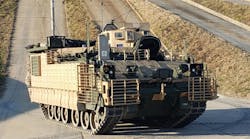The U.S. Army awarded BAE Systems a $797 million contract to begin full-rate production of the Armored Multi-Purpose Vehicle (AMPV), the first newly designed tracked vehicle to enter the Army’s fleet in three decades. The AMPV is a family of next-generation armored vehicles meant to replace legacy M113 and other armored vehicles from the Vietnam War era. Options for the AMPV contract could extend its potential total value to nearly $1.6 billion.
The AMPV leverages design aspects from the Bradley Infantry Fighting Vehicle and the M109A self-propelled howitzer (see image above). It's being planned as an essential component of the Armored Brigade Combat Team (ABCT), providing protection, interoperability, and mobility with high reliability. The AMPV is designed to operate alongside M1 Abrams tanks and M2 Bradley vehicles.
Jeremy Tondrealt, president of the Platforms & Services sector at BAE Systems, said, “Entering full-rate production is a momentous milestone in the lifecycle of a production program for both the U. S. Army and BAE Systems.” He noted its place in history: “The AMPV is the next-generation replacement for the venerable M113, and we are proud that this critical capability is on its way to the men and women who need our most capable combat vehicles on the front lines.”
The Army first awarded BAE Systems the AMPV contract in 2014, followed by a low-rate-initial-production (LRIP) contract in 2018. The first LRIP vehicle was delivered in 2020.
